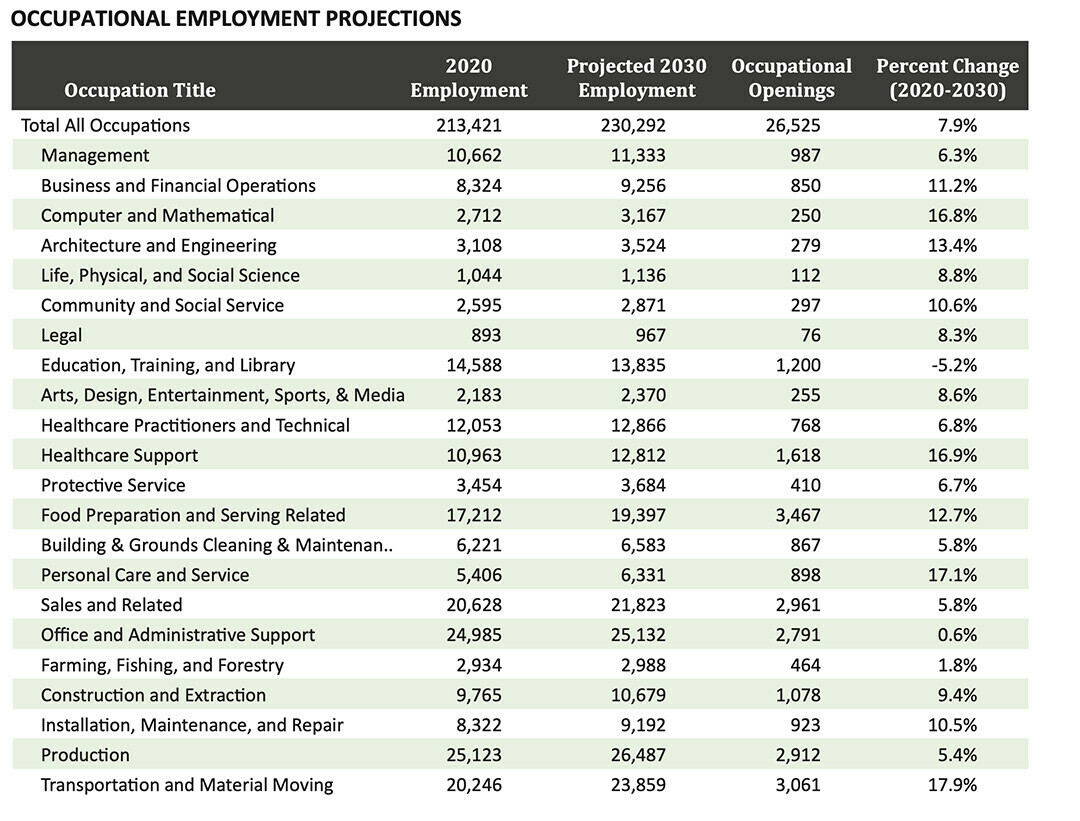Six Things to Know About the Future of the Chippewa Valley Job Market
peeking at projections about job growth and demographic change

“Gyrations” aren’t just for the dance floor – they can happen in the labor market, too. That’s one of the messages of the most recent workforce profile for Eau Claire County from the state Department of Workforce Development. The report, which came out last summer, is chockfull of important data, including a reminder that in today’s world, the job market – and the economy as a whole – can be volatile.
Consider, for instance, just where the Wisconsin labor market was in April 2020, when the state unemployment rate spiked to 14.1% in the initial weeks of the pandemic. Two years later, in April 2022, it had plunged to 2.8% (a record low), and as of April 2024 it was just 2.9%. (Those are the “employment gyrations” referenced above.)
Pandemics aside, there are plenty of forces, big and small, pulling on the labor market in the nation, state, and right here in the Chippewa Valley. Among the biggest is demographic change, as an aging population moves out of the workforce. Here are some of the biggest takeaways and most notable stats from the report (which you can find in its entirety as a PDF here).
LABOR FORCE PARTICIPATION IS A LITTLE LOW … The labor force participation rate in Wisconsin – basically, the share of working-age people who have jobs – was 64.6% as of the end of 2022, a full 2 percentage points below the national average. This is attributed to baby boomers (born between roughly 1946 and 1964) aging out of the workforce.
… AND THAT’S THE BIGGEST CHALLENGE. “Workforce quantity is the primary challenge facing Wisconsin’s economic future,” the report notes. “The demographic dynamics facing the state, other Upper Midwest states, the U.S., and most of the developed economies will advance unaltered in the coming decades.” While the Badger State’s population is expected to keep growing for the next two decades, “the number of retiring baby boomers nearly match the influx of new workers,” which leads to slow workforce growth.
LOCALLY, WE’RE YOUNG AND GROWING. The news is more positive locally, however: Eau Claire County gained an estimated 2,309 residents between 2020 and 2020, a growth rate of 2.2%, much higher than the statewide rate of 0.9%. The median age in the county is 35.2, the third youngest among Wisconsin’s 72 counties. (By comparison, the median age in Chippewa County is 41.3 and Dunn County is 35.3.)
WE’RE HEALTH CARE HEAVY. Education and health care accounted for 28.5% of jobs in Eau Claire County as of 2021 (the latest year for which full statistics were available). While the report says that these sectors “tend to be somewhat recession resistant,” it goes on to mention that some health care workers were furloughed during the height of COVID-19. Furthermore, the recent closure of two hospitals and the region’s Prevea clinics have shown that health care jobs aren’t completely stable even beyond the pandemic.

SO WHAT OCCUPATIONS ARE GROWING? An important question, considering this whole section of the magazine is titled “Where the Jobs Are”! According to a handy chart of projections in the report, a number of occupations are expected to have double-digit growth between 2020 and 2030. They include: transportation and material moving, 17.9% (thanks, online shoppers!); personal care and services, 17.1%; health care support, 16.9%; computer and mathematical, 16.8%; and architecture and engineering, 13.4%. Overall, the number of jobs is expect to grow nearly 8% over the course of the 2020s, with an estimated 26,525 occupational openings (get your résumés ready).
AND WHICH AREN’T? The only occupational sector that’s predicted to actually shrink in Eau Claire County by 2030 is composed of education, training, and library jobs, down 5.2% (a loss of about 743 positions). Nonetheless, there are still projected to be 1,200 occupational openings in that sector, presumably because of people aging out of the workforce or switching jobs. Other low-growth occupations are forecast to be office and administrative support (0.6%) and farming, fishing, and forestry (1.8%).
For workforce profiles of all Wisconsin counties and other data, visit jobcenterofwisconsin.com.

